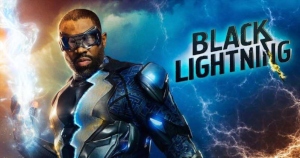“Black Lightning” (9 p.m. Eastern Tuesdays, CW) distinguishes itself from the other CW DC Universe shows by being set in a real world more so than a cartoony world. It’s much closer to the dramatic parts of “Atlanta” than the silliness of “Supergirl” (which is easily the dumbest show I’ve ever watched 52 episodes of).
Freeland feels like Atlanta
Although set in the fictional city of Freeland (the comic is set in a slummy part of Metropolis, but I guess the TV show wanted to distance itself from Superman), “Black Lightning” feels like Atlanta, probably because it’s filmed there. Most of the characters are black people who spend most of their time around black people; it adds diversity to the TV landscape, but not within itself.
Writer-director Salim Akil, the show’s co-creator with Mara Brock Akil, effectively makes a viewer who isn’t from the inner city feel like an outsider in the pilot episode, “The Resurrection.” The issues are certainly recognizable from our Facebook feeds, though. It’s a cliché when the title character – a principal-by-day named Jefferson Pierce (Cress Williams from “Veronica Mars” and “Friday Night Lights”) – gets pulled over for a DWB.

“Black Lightning” (2018)
Tuesdays, CW
Creator: Salim Akil
Stars: Cress Williams, Nafessa Williams, Christine Adams
But it’s a necessary cliché for understanding the way everyday annoyances can get under his skin and inspire him to return to the guise of the electricity-absorbing-and-shooting Black Lightning, which he had abandoned years ago.
At the episode’s start, his daughter, Jennifer (former Disney Channel star China Anne McClain), protests a powerful gang called The 100, and it’s arguably a case of a mainstream TV show using the gang as a stand-in for the really dangerous gang, the police, which is being protested in the real world for its military tactics and violence toward citizens. The DWB scene buys some legitimacy back, though, and I will admit that the portrayal of The 100 is truly scary.
City is run by crime syndicate
The gang is led by Lala (William Catlett), who does standard things like beat the pulp out of his underlings. But what’s really scary is that he hasn’t merely carved out a slice of the guns-and-drugs trade; rather, he seemingly runs the city, and it’s easy to stumble into his clutches. Jennifer goes to The 100’s home bar – which, granted is not a good idea – and she is on an inadvertent path to becoming a showgirl in one of The 100’s illicit ventures before BL intervenes.
What’s more, Lala’s charges barge right into Garfield High School, guns brandished, and kidnap Jennifer and Jefferson’s older daughter, the teacher Anissa (Nafessa Williams). Police officer Inspector Henderson (Damon Gupta of “Bates Motel”) is a potential ally despite Jefferson’s brushes with street cops, but it’s clear that the police are the underdogs against The 100.

Although it’s tempting to compare Principal Pierce with Morgan Freeman’s character in “Lean on Me,” Garfield isn’t a too-far-gone school that needs to be rescued from the brink. It’s a quite nice-looking building with no metal detectors – something Pierce believes strongly in, as a way to minimize at least the imagery of the public-school-to-prison pipeline. He says he’s done more good as a principal than as a superhero, and while some specifics would be nice, the claim is backed up if we judge the book by its cover.
The details of Jefferson’s initial stint as Black Lightning, who comes from a comic that started in 1977, aren’t revealed in the pilot episode. We just know he became Black Lightning in order to take out Tobias Whale (Marvin Jones III), a crimelord who even Lala answers to, but Tobias is still very much running the crime show in Freeland.
So one wonders why he hung up the Black Lightning suit (designed by his very own Alfred, James Remar’s Peter Gambi, who has a mini-Batcave below his clothing store). I guess it was to mollify his wife, Lynn (Christine Adams), but they are divorced, so it seems he’s free to fight evil.
Vigilante or hero?
I don’t mind that we’re entering the second chapter of Black Lightning’s story, as the origin story seems rather standard and it’s refreshing to see a SOTA (Superhero Older Than Average); we don’t learn his age, but the actor is 47.
When BL dons the suit again in order to rescue his daughters (it’s unclear if his girls recognize him, as would be common sense, or if this is like “Supergirl” where they are magically blinded to the connection), he emerges into a world where some people are happy he’s back and some believe he’s just as bad as the criminals he stops.
In a brief TV news clip, a pundit wonders why BL is labeled a “vigilante” whereas Superman is a “hero,” and that’s a good question. If the answer is “Because Black Lightning is black,” that’s a bit heavy-handed in a show that’s otherwise at least a bit more subtle.
Still, there’s a lot to like here, notably the fact that it’s the first of the modern crop of DC shows to be set in a ripped-from-the-headlines (and not watered down) world, as opposed to the broad and cartoony quartet of “Supergirl,” “The Flash,” “Arrow” and “Legends of Tomorrow,” and the stylized “Gotham.”
It’s probably too much to hope that “Black Lightning” digs deeply into the issues. While the superhero’s frustration with the city’s police-and-gang state is palpable, we don’t get any sense that BL grasps the reasons for the problem and strategies for rooting out the entrenched evil. For now, going out and banging some heads is a viscerally satisfying, if temporary, solution.

